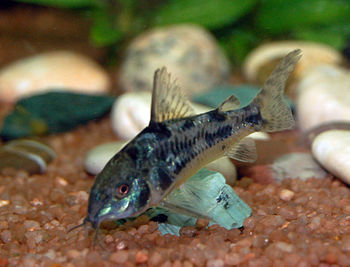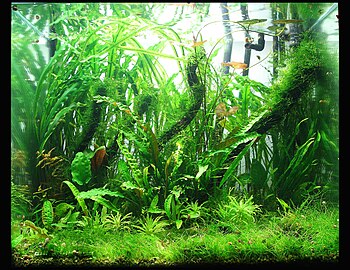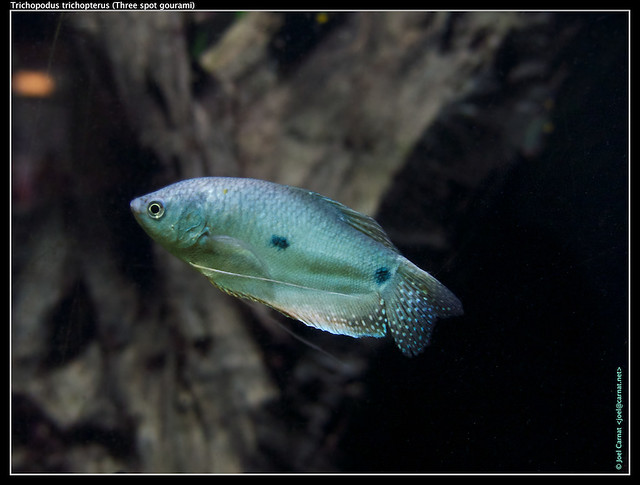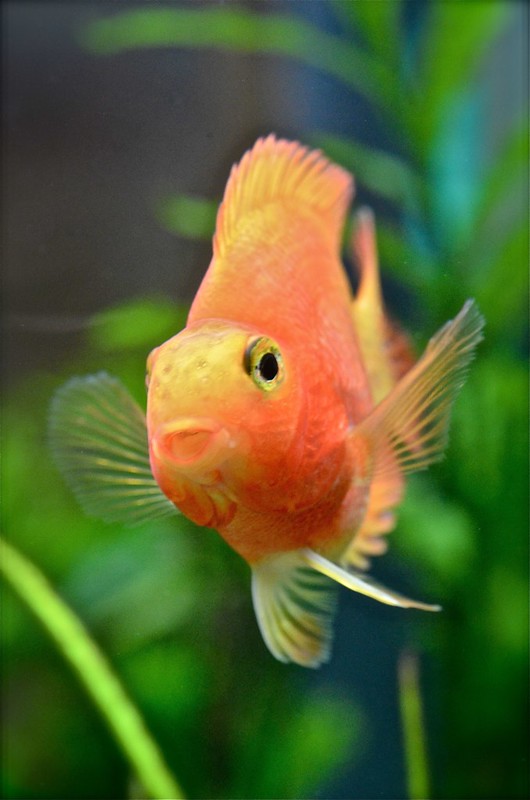 |
| Gulf Killifish - Fundulus grandis |
2018-02-06
2018-02-05
4 Popular CATFISH - Great Tips On Catfish Care
 |
| Corydoras paleatus (Photo credit: Wikipedia) |
There are so many different types of catfish and they range in sizes and shapes. There are the Mekong giant catfish that grows to six feet long. This is obviously a fish you aren't going to own. There are catfish that are easier to keep than others. The catfish in this article include the Black Spotted Corydoras, Peppered Corydoras, Leopard Corydoras and Loricariidae.
1. Black Spotted Corydoras: This catfish comes from Venezuela and Guiana and can grow to a little over two inches in length. The reason for the name is pretty obvious when you see it. It's silver with black spots. Black Spotted catfish make good pets. They aren't aggressive and are peaceful animals. They prefer to eat white worms or tubifex but will eat fish flakes.
2. Peppered Corydoras: The brown colored fish hails from Brazil. It also has spots on it but not as prominent as other catfish. Like other catfish, it handles communal tanks and cleans the tank well. It feeds on white worms, Tubifex, and flakes. The Peppered catfish enjoys the slightly acidic water, so check the pH level. It enjoys swimming in hard water.
3. Leopard Corydoras: The Leopard catfish is from the lower Amazon. The reason for the name is the dark spots over the silvery body that tends to form lines near the tail. The Leopard catfish is an easy fish to own. It's calm with other fish and doesn't act aggressively. It enjoys similar water conditions to the Peppered catfish and eats the same items. These fish usually swim around the bottom of the tank looking for food that the others have missed.
4. Loricariidae: These fish are covered in bony plates and are a hit with fish lovers. They have a suckermouth and clean up tanks as good as a vacuum. They love eating the algae and other tiny organisms, which makes cleaning the tank easier. These fish shouldn't be used as a substitute for cleaning. Cleaning must still be maintained. Most species of this catfish are nocturnal so you might not see them out during the day. They prefer slightly acidic water (6.0 - 7.5 pH) and a temperature between 72-82 degrees Fahrenheit. They are good in tanks with other fish but might fight with fish of their own species. These fish enjoy worms, insect larvae, and algae. They should be fed in the evening. Many of these fish are sold just for their algae eating purposes. Some of them can grow to be large fish, but many stay relatively small, sucking up the algae at night. There are some of these that are bred in captivity because they are such a popular fish.
Catfish are a great fish to have in your aquarium. Besides eating the algae and making your cleaning duties easier, they get along well with other fish. This is important because, with territorial fish, you can spend time trying to find the right combination of fish to put in your tank without them killing each other. Catfish come in many colors and varieties. Find the one you like best and enjoy the peaceful nature and low maintenance it brings to the tank.
Abhishek is an avid Fish Lover and he has got some great Aquarium Care Secrets up his sleeves!
Article Source: EzineArticles
|
2018-02-04
Fifty five Gallon Fresh Water Aquarium
 |
| Photo: Wikimedia |
You will need a heater for temperature control, and a thermometer for checking the water temperature. It will take approximately five bags of rock or other substrates to line the bottom of the tank. Choose a bright color to add some interest to the aquarium.
In addition, you will need to purchase a filter for the tank. Filters can be complicated. Do a lot a research to find out what type of filter is suggested for the fish that you choose. There are filters that go beneath the substrate in the bottom of the tank, as well as filters that attach to the side of the aquarium. They also vary greatly in price. It is not necessary to buy the most expensive filter when setting up a basic freshwater aquarium.
The aquarium will also need lighting. Again, based on personal preference you can keep it simple or get very technical. Most fish will respond nicely to a basic light that is simply turned on for a few hours each day. An aquarium should contain some form of plants for added interest. The plants serve a place for the fish to seek refuge and feel safe. There are many varieties of freshwater plants that would work nicely in a fifty-five-gallon aquarium. Just be sure to purchase an aquatic specific species. If you don't want the hassle of live plants, plastic is always an option. They have come along way with synthetic plants. In most cases, the fish may not even notice the difference, unless of course, they try to eat them.
Once your tank is established and you are ready to add fish, choose your fish carefully. Start with hardy fish, such as livebearers, gouramis, barbs, and danios. These fish are hardy enough to handle higher nitrate levels in the tank. Allow about thirty days for these fish to become acclimated to the tank, before adding any new fish. It usually takes about thirty days for the symptoms of ich or other fish illnesses to show up. It is important to make sure that all existing fish are healthy before adding any new species. The transportation of new fish itself is stressful enough, without having to add disease to the situation. When purchasing fish, it is important to remember that a fifty-five-gallon aquarium can handle about fifteen to twenty small fish total. This will allow plenty of growth room for the fish.
2018-02-03
AQUARIUM PLANTS: One Of The Best Ornaments In An Aquarium
 |
| An aquatic garden with mostly Cryptocoryne species. (Photo credit: Wikipedia) |
Most of the fishes feel secure, less stressed and safe whenever they have plants to hide in. Some species of fish do not survive in an aquarium without any plants.
Aquarium plants will not only give the fishes a helpful shelter and make your aquarium look attractive but they can maintain the quality of the water as well. Plants and fish both exist in the wild and they will surely match well in your aquarium.
The wastes discharged by the fish contain compounds that are useful for the plant’s nutrition. Therefore, the organic wastes can be contained in the plants instead of seeing them float in the water. The plants must be pruned regularly and the dead parts must be eliminated from the aquarium ASAP.
Most species of fish will never reproduce in an aquarium without plants. This is because some species need plants for them to feel secure enough to reproduce, while other species need the leaves of the plants to place their eggs in. An abundantly planted aquarium will also enhance the survival growth of the fry especially if you want to increase the number of fry in a similar aquarium like with the adult fish.
However, we all know that plants rely too much on to light and photosynthesis. An aquarium with no plants will only need little. But if you are planning to have an abundant number of plants in your aquarium, you will be required to put new lights. A fluorescent light will be better for your planted aquarium, make sure that they are made especially for aquariums.
If you are a beginner, the plant species that will be suitable for you are the Java Moss and the Java Fern. These are strong plants that can survive in water hardness and pH values. They can even be placed in a brackish aquarium like the Molly aquarium.
Aquarium plants are very important to the survival of most fishes in the aquarium. It does not matter what aquarium plant you choose, the important thing is you know how to maintain your aquarium as naturally as the fishes and plants habitat.
|
2018-02-01
The Breeding of Extremely Popular Species - The BLUE GOURAMIS
 |
| Photo by Joel Carnat |
If you try to find out three spots on their body, you may get confused. In reality, there are only two spots - one in the middle of their body and the other one at the beginning of their tail. However, their eye is also considered one spot, which makes them a three spots fish.
Blue Gouramis can change their color according to their mood. Especially during the spawning period, their mood is the best and their colors really shine. They have a labyrinth organ which means they can gulp care directly from the atmosphere. This feature makes them tougher because they can easily survive in low oxygen water.
As the adults grow up to 5 inches, they are ready for reproduction. Their colors will brighten and they tend to get aggressive. In case of females, their breast will be swollen. During the spawning period, you should provide enough space for them to swim and hide because due to excessive aggression by males, they may get injured.
When the spawning begins, the male will build up a bubble nest. After bidding, the male will try to encourage the female to go under it. He will swim around the female and indicate her to go under the bubble nest. When the female is ready, she will bite the male at his back and in response, the male will brush his body against the belly of the female.
During the spawning process, the male will wrap his body tightly around the body of the females to ensure that the eggs will float to the surface without any hassle. As the sperms will survive only for a few minutes, it is important for the male to ensure that they are as close to the eggs as possible.
As soon as the sperms reach the bubbles nest, the eggs get fertilized. This process is repeated for a lot of times and it may take several hours. The eggs are produced in thousands so the possibility of new ones coming out is high.
Ones this process is completed, the job of the females is over. At this point in time, you should remove all the females from the breeding tank because the males will attack them for protecting the eggs! Till the time of hatching, the males will protect the eggs. They will also scrutinize the eggs and rearrange them. During this time, you will see an interesting incidence - the males will spit the streams of water over them for cleaning and positioning the eggs. This spitting is also useful for preventing insects to hang around the eggs.
The hatching time is about 30 to 40 hours. The new ones will come out and they will start eating right from the first day. This is a crucial time for the fry because they're all of the organs including the labyrinth organ will be developed. They should be fed with good live food like baby shrimp during this time.
The new ones should be kept in a separate tank for at least two months. Once they are fully grown, you can shift them to the main aquarium.
Chintamani Abhyankar is a goldfish enthusiast and has been raising and breeding goldfish for many years. He is an expert on their care and an advocate for raising healthy goldfish the natural way.
Article Source: EzineArticles
|
2018-01-31
GOLDFISH Maintenance
 |
| Photo by You As A Machine |
Goldfishes can be kept in an aquarium with cold water. According to the popular perception, goldfishes should have to be kept in a goldfish bowl. But what people do not realize is that the decreased water surface area provides lesser oxygen to the fishes, which can result in difficulty in respiration. The fishes also die very quickly because of ammonia or nitrite poisoning. Hence, goldfish bowls have been banned in many countries. Also, goldfishes that are kept in bowls have a shorter lifespan. One medium sized goldfish need a minimum of ten gallons of water. Goldfishes intoxicate the water very quickly with their feces and the chemicals released from their gills. The water should be cleaned regularly otherwise the fishes can die in a short period. The water surface area should be considered when introducing new fishes to the aquarium, because of more the water surface area, more the diffused oxygen. The water can also be aerated with the help of filter or water pump. Goldfishes cannot survive sudden water temperature shifts. This usually happens in winters, when the heating is turned on.
The goldfishes shouldn’t be touched because it would result in a slimy coating on its body coming out, which exposes the skin to bacterial infection. This is very dangerous to the health of the fish. Goldfishes, when kept in dark will lose their color. This is because they have pigments in the cells, similar to the pigments in human, which causes it to become tan. Therefore, lights should be installed in closed rooms. A full hood can be used to provide adequate light. But if the aquarium has water less than thirty gallons, then the room lights will do the job. Also, the aquarium can be placed in the natural light, if it is available.
Goldfishes are opportunistic feeders, that is, they will eat whenever food is provided to them. The more the food is given to them, the more the waste created. They should be given food only twice a day and the quantity must be only that much which it can finish in a couple of minutes. The food should have high carbohydrate and low protein, as the fish will be unable to digest proteins well because of the lack of stomach. Other than the commercial food flakes and pellets, they can also be given bloodworms and green leafy vegetables. If the fishes are overfed, it could lead to the bursting of their intestines.
The goldfish can grow up to twenty-three inches and can weigh up to ten pounds. There are known to live for twenty years, but in captivity, they live for eight years. Goldfishes although are good in aquariums, they can also be kept in ponds. The depth of the water should be more than thirty inches so that the water doesn’t freeze in winter. Plants should also be added to the pond as they will filter the water and even increase the oxygen amount in the water. Along with that, filters should also be used to the clean the pond water. Ponds are a good place to breed goldfishes. Water surface should be one square foot for each inch of fish’s length.
are a good place to breed goldfishes. Water surface should be one square foot for each inch of fish’s length.
The goldfishes kept in the aquarium and as well as in the ponds should not be mixed with tropical fishes or any other kind of fish. Since most of the goldfishes are hybrid variety, they are more prone to attacks. Some fishes not only attack the goldfishes but also suck on their wounds.
2018-01-30
Chicago SHEDD AQUARIUM, Discover Teeming Life Under the Water
 |
| The Shedd Aquarium in Chicago, viewed from the southeast. (Photo credit: Wikipedia) |
I love the ocean, and visiting is generally one of my favorite things to do. The best part about Chicago is that they have not only water but then I can see exactly what goes on under the water at the aquarium all around the world.
Here's what you can expect from a day at the Shedd Aquarium a fantastic exploration of the waters from the:
° Oceanarium, dolphin performances, sea otters and et.° Caribbean Reef, sharks, jellyfish, the dangerous waters off the Caribbean coasts° Amazon Alligators, snakes, spiders more amazing creatures° The Wild Reef, showing eels more sharks, beautiful schools of various fish and much more
I love this place because this amazing Aquarium brings you face to face with some of the most amazing creatures.
One of my favorite visits I was with my husband and we were looking at these rocks which were about a foot or so from the glass all propped together, we were looking for any sign of life inside this particular tank when we noticed an eye looking at us from this small hole, about five inches around. I wasn't quite sure what eye was staring back at me. I quickly discovered that it was an octopus, the entire eight-foot octopus squeezed out of this tiny hole and filled the entire length of the glass in front of us! It was so amazing to see just how small they can make themselves and just how big they can get when they're fully stretched out. It almost seemed like a different creature!
The Chicago Shedd Aquarium really makes the underwater world come to life! Each exhibit makes it feel like you're really there!
It's an amazing place to take family friends or to even go alone. Plus they have discount days on occasion and delicious restaurants on site. It's really a lot of fun and quite an experience for the everyone.
|
Subscribe to:
Posts (Atom)

